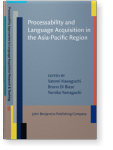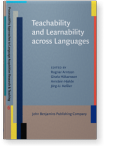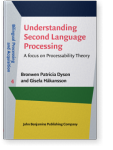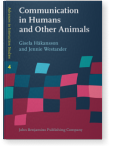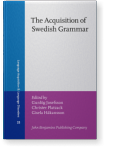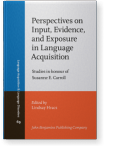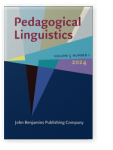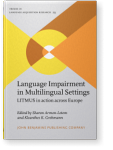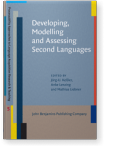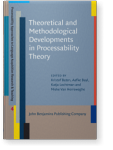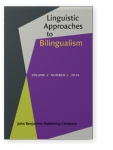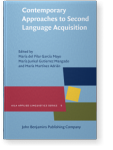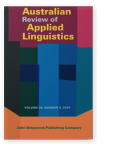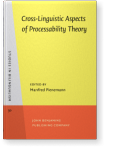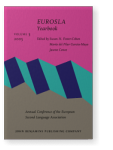Gisela Håkansson
List of John Benjamins publications for which Gisela Håkansson plays a role.
Book series
Teachability and Learnability across Languages
Edited by Ragnar Arntzen, Gisela Håkansson, Arnstein Hjelde and Jörg-U. Keßler
[Processability Approaches to Language Acquisition Research & Teaching, 6] 2019. vii, 263 pp.
Subjects Applied linguistics | Cognition and language | Language acquisition | Language teaching | Psycholinguistics
Understanding Second Language Processing: A focus on Processability Theory
Bronwen Patricia Dyson and Gisela Håkansson
[Bilingual Processing and Acquisition, 4] 2017. xi, 211 pp.
Subjects Cognition and language | Language acquisition | Multilingualism | Psycholinguistics
Communication in Humans and Other Animals
Gisela Håkansson and Jennie Westander
[Advances in Interaction Studies, 4] 2013. xi, 242 pp.
Subjects Cognition and language | Communication Studies | Evolution of language | Interaction Studies | Philosophy
The Acquisition of Swedish Grammar
Edited by Gunlög Josefsson, Christer Platzack and Gisela Håkansson
[Language Acquisition and Language Disorders, 33] 2004. vi, 313 pp.
Subjects Generative linguistics | Germanic linguistics | Language acquisition | Syntax
2024 Chapter 9. Speech modifications and the Processability Theory hierarchy: Some observations on word order in Swedish L1 and L2 input Perspectives on Input, Evidence, and Exposure in Language Acquisition: Studies in honour of Susanne E. Carroll, Hracs, Lindsay (ed.), pp. 226–244 | Chapter
This study explores to what extent there is a difference in input in L1 and L2 Swedish regarding word order. Swedish is a V2 language with only one constituent preceding the tensed verb. This phenomenon is acquired in different ways by L1 and L2 learners. L1 learners produce V2 without errors… read more
2024 What is in the learner’s mind when trying to verbalize grammatical rules? English third-person singular -s in two settings, Sweden and Vietnam Pedagogical Linguistics 5:1, pp. 56–75 | Article
The present study examines the outcome of teaching second language English (L2 English) third-person singular present tense -s for declarative knowledge in two different settings, namely Sweden and Vietnam. Third person -s is one of the most studied grammatical structures in second language… read more
2021 A case study of a quadrilingual child: The influence of exposure and cognates when developing multiple languages Language Impairment in Multilingual Settings: LITMUS in action across Europe, Armon-Lotem, Sharon and Kleanthes K. Grohmann (eds.), pp. 77–98 | Chapter
This paper reports on a case study of a quadrilingual child, Stefan, born and raised in Sweden and exposed to four languages before his first birthday: English, French, Russian and Swedish. We examine his vocabularies in these languages by the Cross-Linguistic Lexical Tasks (Haman, Łuniewska, &… read more
2019 Introduction Teachability and Learnability across Languages, Arntzen, Ragnar, Gisela Håkansson, Arnstein Hjelde and Jörg-U. Keßler (eds.), pp. 1–6 | Chapter
2019 Chapter 2. How much English do children know before they are exposed to instruction? Applying Processability Theory to receptive grammar Teachability and Learnability across Languages, Arntzen, Ragnar, Gisela Håkansson, Arnstein Hjelde and Jörg-U. Keßler (eds.), pp. 27–49 | Chapter
This study investigates how much English Swedish-speaking children are able to extract from media prior to the instruction of English that takes place in school. The participants are 41 Swedish-speaking, 7 to 8-year-old children in grades 1 and 2. Their receptive knowledge of English grammar and… read more
2016 Processability Theory and language development in children with Specific Language Impairment Developing, Modelling and Assessing Second Languages, Keßler, Jörg-U., Anke Lenzing and Mathias Liebner (eds.), pp. 65–78 | Article
Children with Specific Language Impairment (SLI) represent a special group among young monolingual children, since they have problems acquiring their first language. Most research deals with English-speaking children, and points to bound morphology as the problematic area. However, cross-linguistic… read more
2015 Chapter 8. Response Paper: Exploring new Grounds – Turning the PT Kaleidoscope Theoretical and Methodological Developments in Processability Theory, Baten, Kristof, Aafke Buyl, Katja Lochtman and Mieke Van Herreweghe (eds.), pp. 169–174 | Article
2013 Chapter 6. Processability Theory: Explaining developmental sequences Contemporary Approaches to Second Language Acquisition, García Mayo, María del Pilar, María Juncal Gutiérrez Mangado and María Martínez-Adrián (eds.), pp. 111–128 | Chapter
This chapter presents a psycholinguistic account of the developmental sequences found in second language acquisition (SLA). Building on Levelt’s (1989) model of speech production, Processability Theory (PT: Pienemann 1998, 2005) proposes that the order in which morpho-syntactic structures are… read more
2007 Girl – lass or curl? World associations in second language learners Australian Review of Applied Linguistics 30:2, pp. 22.1–22.17 | Article
One of the ways to investigate the mental lexicon is to use word association tests. Empirical studies comparing associations by children and adults have indicated a tendency for children to give syntagmatic responses, whereas adults give paradigmatic responses. In order to investigate lexical… read more
2005 6. Similarities and differences in L1 and L2 development. Opening up the perspective: including SLI Cross-Linguistic Aspects of Processability Theory, Pienemann, Manfred (ed.), pp. 179–197 | Chapter
2005 Grammar and pragmatics: Swedish as a foreign language EUROSLA Yearbook: Volume 5 (2005), Foster-Cohen, Susan H., María del Pilar García Mayo and Jasone Cenoz (eds.), pp. 137–161 | Article
This paper compares grammatical and pragmatic development in foreign language learners of Swedish. For the analysis of grammatical proficiency, data from translation tasks and essays were tested against the stage model proposed in Processability Theory, which identifies five stages of… read more
2005 3. Processability, typological distance and L1 transfer Cross-Linguistic Aspects of Processability Theory, Pienemann, Manfred (ed.), pp. 85–116 | Chapter
2004 Swedish language learner corpora The Acquisition of Swedish Grammar, Josefsson, Gunlög, Christer Platzack and Gisela Håkansson (eds.), pp. 23–29 | Article
